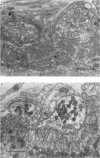Abstract
1. Rat soleus and extensor digitorum longus (EDL) muscles were examined following complete blockade of sciatic nerve impulses with anaesthetics or diphtheria toxin for periods up to 14 days.
2. Muscles showed atrophy equivalent to that seen after similar periods of denervation.
3. Nerve blockade appeared to have little or no effect on neuromuscular transmission when tested by stimulation beyond the block. Normal spontaneous miniature end-plate potentials were present.
4. Nerve impulse blockade caused the entire muscle membrane to become sensitive to iontophoretically applied acetylcholine.
5. The increase in sensitivity in soleus could be prevented by chronic nerve stimulation distal to the region of block.
6. Tenotomy, of 5-12 days duration, which produced atrophy, had no effect on the sensitivity of soleus to acetylcholine.
7. Chronic direct stimulation of denervated soleus or EDL muscles could prevent the usual denervation supersensitivity, or cause it to decline towards normal once it had appeared. However, the sensitivity of the end-plate region remained normal.
Full text
PDF






















Images in this article
Selected References
These references are in PubMed. This may not be the complete list of references from this article.
- AXELSSON J., THESLEFF S. A study of supersensitivity in denervated mammalian skeletal muscle. J Physiol. 1959 Jun 23;147(1):178–193. doi: 10.1113/jphysiol.1959.sp006233. [DOI] [PMC free article] [PubMed] [Google Scholar]
- DIAMOND J., MILEDI R. A study of foetal and new-born rat muscle fibres. J Physiol. 1962 Aug;162:393–408. doi: 10.1113/jphysiol.1962.sp006941. [DOI] [PMC free article] [PubMed] [Google Scholar]
- Duchen L. W., Stefani E. Electrophysiological studies of neuromuscular transmission in hereditary 'motor end-plate disease' of the mouse. J Physiol. 1971 Jan;212(2):535–548. doi: 10.1113/jphysiol.1971.sp009340. [DOI] [PMC free article] [PubMed] [Google Scholar]
- Fischbach G. D., Robbins N. Changes in contractile properties of disused soleus muscles. J Physiol. 1969 Apr;201(2):305–320. doi: 10.1113/jphysiol.1969.sp008757. [DOI] [PMC free article] [PubMed] [Google Scholar]
- Fischbach G. D., Robbins N. Effect of chronic disuse of rat soleus neuromuscular junctions on postsynaptic membrane. J Neurophysiol. 1971 Jul;34(4):562–569. doi: 10.1152/jn.1971.34.4.562. [DOI] [PubMed] [Google Scholar]
- JOHNS T. R., THESLEFF S. Effects of motor inactivation on the chemical sensitivity of skeletal muscle. Acta Physiol Scand. 1961 Feb-Mar;51:136–141. doi: 10.1111/j.1748-1716.1961.tb02121.x. [DOI] [PubMed] [Google Scholar]
- JOSEFSSON J. O., THESLEFF S. Electromyographic findings in experimental botulinum intoxication. Acta Physiol Scand. 1961 Feb-Mar;51:163–168. doi: 10.1111/j.1748-1716.1961.tb02124.x. [DOI] [PubMed] [Google Scholar]
- Jacobs J. M., Cavanagh J. B., Mellick R. S. Intraneural injection of diphtheria toxin. Br J Exp Pathol. 1966 Oct;47(5):507–517. [PMC free article] [PubMed] [Google Scholar]
- Jones R., Vrbová G. Effect of muscle activity on denervation hypersensitivity. J Physiol. 1970 Sep;210(2):144P–145P. [PubMed] [Google Scholar]
- KATZ B., MILEDI R. THE DEVELOPMENT OF ACETYLCHOLINE SENSITIVITY IN NERVE-FREE SEGMENTS OF SKELETAL MUSCLE. J Physiol. 1964 Mar;170:389–396. doi: 10.1113/jphysiol.1964.sp007339. [DOI] [PMC free article] [PubMed] [Google Scholar]
- KATZ B., THESLEFF S. On the factors which determine the amplitude of the miniature end-plate potential. J Physiol. 1957 Jul 11;137(2):267–278. doi: 10.1113/jphysiol.1957.sp005811. [DOI] [PMC free article] [PubMed] [Google Scholar]
- Libelius R., Sonesson B., Stamenović B. A., Thesleff S. Denervation-like changes in skeletal muscle after treatment with a local anaesthetic (Marchaine). J Anat. 1970 Mar;106(Pt 2):297–309. [PMC free article] [PubMed] [Google Scholar]
- MARTIN A. R. A further study of the statistical composition on the end-plate potential. J Physiol. 1955 Oct 28;130(1):114–122. doi: 10.1113/jphysiol.1955.sp005397. [DOI] [PMC free article] [PubMed] [Google Scholar]
- MILEDI R. The acetylcholine sensitivity of frog muscle fibres after complete or partial devervation. J Physiol. 1960 Apr;151:1–23. [PMC free article] [PubMed] [Google Scholar]
- McDonald W. I., Sears T. A. Effect of a demyelinating lesion on conduction in the central nervous system studied in single nerve fibres. J Physiol. 1970 Apr;207(2):53P–54P. [PubMed] [Google Scholar]
- Miledi R., Slater C. R. Electrophysiology and electron-microscopy of rat neuromuscular junctions after nerve degeneration. Proc R Soc Lond B Biol Sci. 1968 Feb 27;169(1016):289–306. doi: 10.1098/rspb.1968.0012. [DOI] [PubMed] [Google Scholar]
- Miledi R., Zelená J. Sensitivity to acetylcholine in rat slow muscle. Nature. 1966 May 21;210(5038):855–856. doi: 10.1038/210855a0. [DOI] [PubMed] [Google Scholar]
- Robert E. D., Oester Y. T. Absence of supersensitivity to acetylcholine in innervated muscle subjected to a prolonged pharmacologic nerve block. J Pharmacol Exp Ther. 1970 Jul;174(1):133–140. [PubMed] [Google Scholar]
- THESLEFF S. Supersensitivity of skeletal muscle produced by botulinum toxin. J Physiol. 1960 Jun;151:598–607. doi: 10.1113/jphysiol.1960.sp006463. [DOI] [PMC free article] [PubMed] [Google Scholar]




